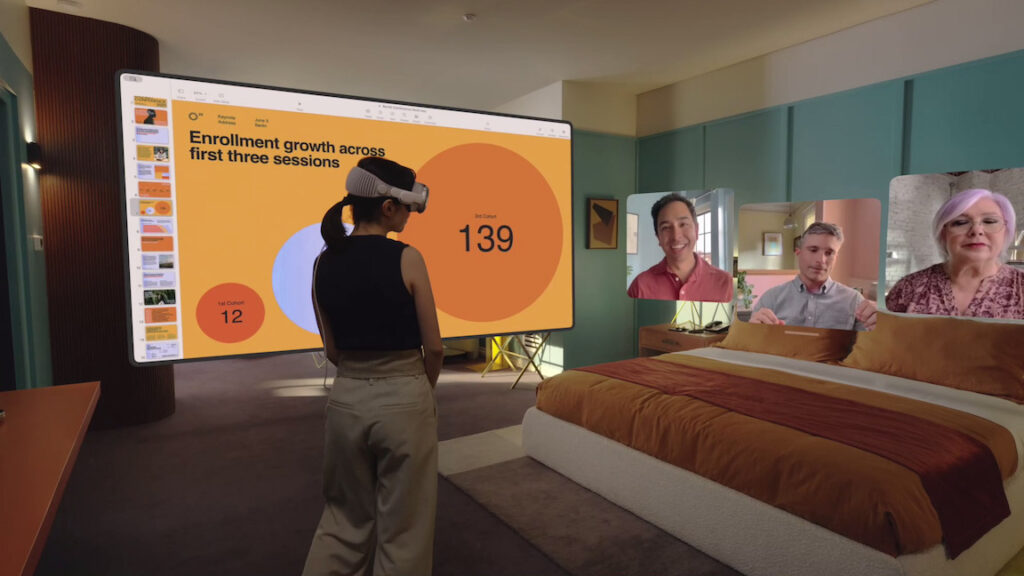Apple To Deliver Vision Pro Earlier – What to Expect
In an unexpected move from the technological company, Apple has fast-forwarded the delivery dates of their latest major entry in the market: the Vision Pro. Although it is often compared to a virtual reality headset, the company has requested that it not be referred to as such by reporters and app developers. The “spatial computer” can be preordered at this time, with its formal release scheduled for February 2nd, 2024.
The device is powered by the M2 chip, the company’s custom-designed system of components that already powers devices like the 2022 MacBook Air. The processor gives the Vision Pro the graphics and performance capabilities to run all sorts of workflows, from light web browsing to heavy-duty three-dimensional simulations. It also comes with the new R1 chip, which serves as the mainframe for the multitude of cameras, sensors, and other telemetry the device uses to display the outside world with accurate colors and depth.
The sensors on board the visor serve as the main input device for the system. Infrared flooders accurately track hand movements that can be used to manipulate the elements on the screen, even in low-light conditions. On top of that, a LiDAR Scanner and a TrueDepth Camera – similar to the ones the latest iPhone 15 Pro is equipped with – work together to precisely scan the surroundings, ensuring maximum immersion and an accurate rendering of the wearer’s environment. It also enables the capability to scan the wearer’s face to design a 3D persona of them, which can be used during FaceTime calls. On top of that, the cameras on both the device and the latest iPhone 15 Pro can capture both photos and video in 3D, being the first system of tridimensional cameras Apple has designed.
The Vision Pro is equipped with three screens: one in the front of the visor and two within. This feature, called EyeSight, works with the custom visionOS system and an array of microphones and sensors. It reveals the user’s eyes when they are not actively using an app or starting a conversation with someone outside of the immersion. The display overlays a blue gradient when the user interacts with an application but can still observe their surroundings, and it fully blocks the view when the user is fully immersed in “Environments”, landscapes that occupy the entirety of the wearer’s screen.
The two remaining screens, placed on lenses for each eye, feature custom micro-OLED displays. They contain far more pixels than most deluxe wide gaming monitors, with over 23 million of them. The screens deliver an incredible quality of the wearer’s surroundings, thanks to a specially designed tri-element lens that creates the feeling of a surrounding display.
Despite its immense array of features and capabilities, the Vision Pro might not appeal to everyone, as some people believe it is missing key features.
“It would be better if you could connect it with your phone, so you can use it for small things too.” Ron Llano, junior, suggests.
Overall, the Vision Pro is primarily targeted at those seeking to elevate their everyday work. Currently, most system features favor apps commonly used in the workplace, including floating keyboards and screen pairing with a Mac device.
Features and apps that could enhance the device’s use in the entertainment and education industries are yet to come. Upon release, users can expect to find popular streaming apps like Disney+, TikTok, and Crunchyroll ready for download. Productivity apps, such as the entire Microsoft Office suite, and the full catalog of Apple Arcade – the company’s entry into exclusive games – will also be available at launch.
However, the general public finds the price tag attached to the device obnoxious. With a cost of $3,499, the spatial computer is unaffordable for most people.
“I don’t doubt it can be a tool schools could use to further expand on what students are learning,” Jorge Borges, sophomore, predicts. “However, it seems that only schools that can afford it will be given that opportunity.”
On the contrary, others are doubtful of the cost/benefit the device conveys.
“I’m not really sure if it’s worth it. I would have to try it first.” adds Areli Mato, senior.
It is currently unclear whether Apple will reduce the price of the Vision Pro. However, the company might launch a new model of the device with fewer features in the near future, considering that the spatial computer is suffixed “Pro”.
For those interested in pre-ordering the device, it is available now on the Apple website. Prospective buyers will need to scan their face dimensions with a Face-ID-enabled iPhone to further customize the fit of the device, and those who wear glasses will also be able to upload a valid prescription to have optical inserts fitted into the device upon arrival.
Apple’s entry into the constantly evolving market of blending reality and computers is incredibly impressive. It will certainly pave the way for the next generation of computer interactions we can expect in the future.
You may be interested
Saying Farewell to the 2023-2024 School Year
Isabella Jimenez - May 17, 2024Isabella Jimenez As soon as I began my high school years back in 2020, I was told by everyone “Enjoy these years while…
May Comic
Katelin Contreras and Isabella Jimenez - May 17, 2024
Upcoming Graduation Day for the Class of 2024
Lucia Menendez - May 17, 2024As the academic year comes to a close, the Watsco Center is preparing to host the graduation ceremony for the Ferguson Falcons on…
Most from this category

















